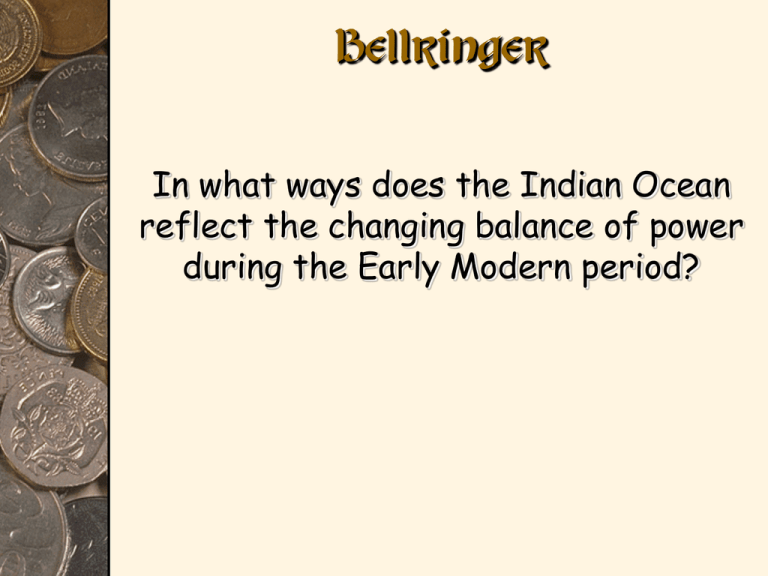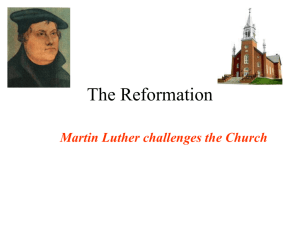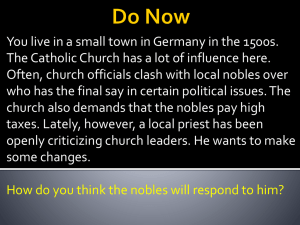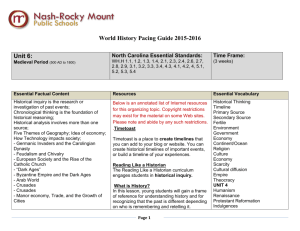The Evolution of the Modern Capitalist System
advertisement

Bellringer In what ways does the Indian Ocean reflect the changing balance of power during the Early Modern period? Evolution of the Early Modern Europe The Fragmentation of Western Christendom The Protestant Reformation Corruption of the Medieval Catholic Church £ Popes used excommunication to force monarchs to obey the Church. £ Many priests were illiterate or broke vows of chastity. £ Some officials lead lives of luxury and leisure. £ Some clergy: Charged repentant Christians to see holy remains and objects. Sold church offices to the highest bidder. Sold indulgences. Why did Luther question Church practices and teachings? £ Troubled by the idea that salvation was attainable through good works. £ Interpreted St. Paul to mean that path to salvation was by faith alone. £ Believed forgiveness for sins could come only from God’s mercy. £ Angered by sale of indulgences. How did his criticisms expand into an effort to form a new church? £ Wrote 95 Theses to start debate on Church abuses. £ Published books and pamphlets questioning Church teachings. £ Ideas for reform led to a new church: Congregations choose their own ministers Worship of saints and holy days was considered sinful Mass conducted in German instead of Latin Clergy allowed to marry. Why did his reforms create widespread revolt in Germany? £ Peasants, believing everyone was equal under God, revolted against lords. £ Princes, who wanted freedom from the pope, seized Church land. Doctrines of Lutheranism £ The Bible is the final authority for faith £ The Bible is translated into the languages of the people £ whatever is not expressly forbidden in scripture can be accepted £ There should be only two sacraments (sanctifies by grace) baptism communion The Reformation Spreads Throughout Europe £ Why did Protestantism spread beyond Germany? Political leaders looked for ways to escape power of Catholic Church. People were tired of Church abuses and corruption. Charismatic individuals questioned Church teachings and provided leadership. Rising literacy rate allowed for rapid spread of new ideas. How did the Catholic Church respond to the Reformation? £ Reformed the Church from Within • Had Church abuses catalogued. • Called meeting at Trent to deal with growth of Protestantism. Council of Trent (1545-1563) • Defined Catholic beliefs and corrected • • • abuses. Sale of indulgences prohibited. Seminaries established to train parish priests. Monasteries and convents cleansed of immoral clergy. £ Tried to Stop the Spread of Protestantism Jesuits (1540) • Disciplined and well-educated order of Catholic priests. • Won Poland and southern Germany back into the Catholic faith. • Spread the Christian message across Africa, Asia, and the Americas. Inquisition (1542) • Church court designed to judge and convict heretics. • Imprisoned exiled or executed those with unorthodox views Index of Banned Books (1559) • List of banned books which Catholics were forbidden to read. • List included Protestant Bibles and some scientific writing. The Fragmentation of Western Christendom £ Witch-Hunts and Religious Wars 110,000 trials for witchcraft Religious conflict in France and Spain The Thirty Years’ War Economics? 1. What is “economics”? 2. What are some basic principles of economics? Postclassical Economy Characteristics of Postclassical Economy 1. Manorialism £ Subsistence farming = serfs £ Lords live off of taxes £ “Old Money” based on landownership and tradition 2. Small guilds develop to encourage artisanry Early Modern Economy 1. Characteristics of Early Modern Economy Mercantilism £ Economic health of a nation could be measured by the amount of gold or silver it possessed £ Favorable balance of trade £ Each nation must try to achieve economic selfsufficiency £ A large population was needed to provide a domestic labor force to people the colonies. £ Luxury items should be avoided • They took money out of the economy unnecessarily. £ State action was needed to regulate and enforce all of these economic policies. • State-sponsored trade monopolies. Characteristics of Mercantilism Manufactured goods Mother Country Capital Colony Cheap labor Raw materials Characteristics of Early Modern Economy 2. Proto-Industrialization / Putting-Out System £ Building of manufacturing income in rural areas £ Source of supplemental income (cottage industries) £ Sign of modern industrial society Characteristics of Early Modern Economy The “Putting-Out” System Advantages of Putting-Out System 1. Peasants could supplement their agricultural incomes. Take advantage of winter months when farming was impossible. 2. Merchants could avoid the higher wages and often demanding regulations of urban labor. Easier to reduce the number of workers when the economy was bad. 3. Merchants could acquire capital, which would later play a part in funding industrialization itself. 4. Young people could start separate households earlier, thus contributing to population growth. Disadvantage of Putting-Out System When demand rose [which it did in the 18c] this system proved inefficient. Merchant-capitalists found it difficult to induce peasant-workers to increase their output. Early Modern Government Rise of the Nation State Rise of the Nation State o Loyalty to nation rather than to ruler o Ruler governed through natural contract with people o Government worked for the interests of the people Flow Chart In order to: show the connection between events in Early Modern Europe & ways that Europe was transformed socially, politically, & economically £ Groups of 4: One person specialize in: • • • • Renaissance Reformation & Commercial Revolution Scientific Revolution Enlightenment Look for the social, political, & economic causes and effects of your specialized topic £ As a group, discuss the causes & effects. Then, create a flow chart of visuals to show connections & transformation






